
|
U. S. CIVIL WAR
PHOTOGRAPHS
|

|
SHILOH
(PITTSBURG LANDING)
(PAGE 2 OF 8)
| |
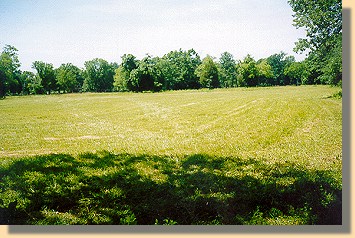
Fraley Field
THE BATTLE BEGINS
As dawn approached on Sunday, April 6, 1862, soldiers in the Union camps near
Shiloh Church began to stir. While some continued to sleep, others prepared for
breakfast. They didn't know that more than 40,000 Southerners with loaded
rifle-muskets and bayonets were marching on them from the southwest.
Suspicious of Confederate activity nearby, Col. Everett Peabody, an alert Union
brigade commander, sent out a reconnaissance patrol of about 200 men under Maj.
James E. Powell. When Powell's patrol entered Fraley Field they stumbled onto
the pickets screening the
Confederate army. Three shots broke the silence, and here fell the first victims
of Shiloh. In the following 34 hours, 3,400 more men would die or be fatally
wounded. screening the
Confederate army. Three shots broke the silence, and here fell the first victims
of Shiloh. In the following 34 hours, 3,400 more men would die or be fatally
wounded.
The fighting in Fraley Field and the surrounding woods lasted about an hour. The
Union patrol was forced to retreat, as the first three waves of the
Confederate assault swept forward. Though not decisive in itself, the initial
engagement gave Union camps to the northeast warning that a Confederate attack
was on the way.
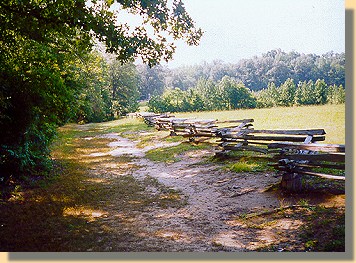
The Sunken Road. (The Hornets's Nest is the woods on the left.)
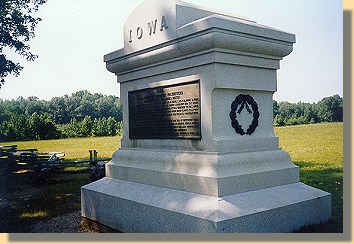
The Iowa Monument on the Sunken Road
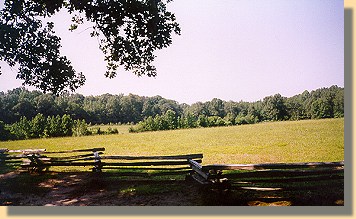
Duncan Field from the Sunken Road
Ruggle Confederate cannon were
near the distant line of trees
After being driven from their camps by attacking Confederates about 9:00 a.m.,
more than 4,000 Union soldiers retreated to the woods and took position along
the "Sunken Road," the dirt wagon trail shown above. Here on high ground
commanding Duncan Field and the adjoining woods, Federal infantry took cover
behind oak trees, fence rails, and dense undergrowth.
During the next eight hours, Confederate infantry charged the road and the
wooded stronghold they called the "Hornets's Nest" eleven times. Repeatedly they
were repulsed by swarms of minie balls. This was the scene of some of the most
desperate and deadly fighting in the Civil War.
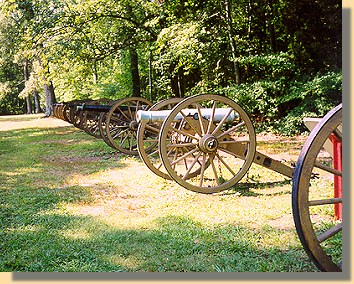
Gen. Ruggles's Confederate Cannon aimed
at the Sunken Road and the Hornets's Nest
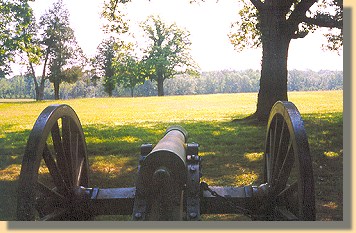
The Hornets's Nest and Sunken Road are
in the distance across Duncan Field
in front of this Confederate Cannon.
After six hours of bloody fighting here, it became evident that Confederate
Infantry alone would not break the strong Union defenses along the Sunken Road
and the thickets beyond. Toward late afternoon, Brig. Gen. Daniel Ruggles brought
forward eleven batteries of artillery
and placed them in line along the wooded edge of Duncan field and beyond. of artillery
and placed them in line along the wooded edge of Duncan field and beyond.
According to Ruggles official report, there were 62 cannon---the greatest
concentration of field guns seen on a North American battlefield up to that time.
For more than an hour Confederate artillery roared, unleashing a great storm of
shot, shell, and canister that kept the
Union soldiers in the "Hornets's Nest" pinned down. Confederate Infantry then
encircled the "Hornets's Nest" and forced its defenders to surrender. that kept the
Union soldiers in the "Hornets's Nest" pinned down. Confederate Infantry then
encircled the "Hornets's Nest" and forced its defenders to surrender.
|
|
PAGE THREE
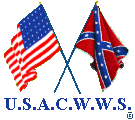 >
Civil War Photos
>
Western Map
>
Shiloh
>
Page 2
>
3
>
4
>
5
>
6
>
7
>
8
>
Civil War Photos
>
Western Map
>
Shiloh
>
Page 2
>
3
>
4
>
5
>
6
>
7
>
8



